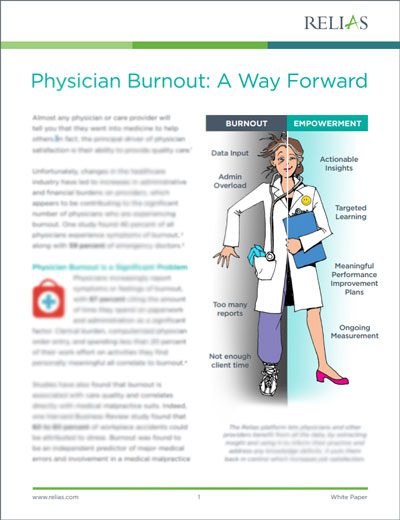When staff are exhausted, experiencing depersonalization from their work and feeling less effective, they are more likely to fail to follow practices that support high-quality, safer care, says Robert Morton, BA, ARM, CPHRM, CPPS, assistant vice president of patient safety and risk management for The Doctors Company in Napa, CA.
The World Health Organization (WHO) has identified burnout as an occupational phenomenon (not a medical condition) in the International Classification of Diseases (ICD-11), Morton notes. The syndrome, which results from chronic workplace stress, is characterized by feelings of exhaustion, increased mental distancing from one’s work or cynicism about work, and reduced professional efficacy.
These symptoms can manifest in many ways in and out of the healthcare workplace, he explains. Some of these include higher rates of error and infections, increased staff turnover, more sick days, lashing out at work, disruptive behavior, complaints from staff and patients, and home-life problems.
Why Burnout Occurs
Healthcare always has demanded more from its workforce than perhaps any other field, notes Helen Hrdy, senior vice president of customer success with NRC Health in Lincoln, NE. The work is unrelenting, it requires the utmost emotional sensitivity, and often, the stakes are literally life and death.
“Add to that the trappings of modern healthcare work — time-consuming EHR systems, complex care protocols, long shifts, and heavier patient loads — and it’s no wonder that 51% of doctors and 41% of nurses report feeling burned out and unengaged. If left unchecked, working in healthcare can make even the most empathetic of clinical staff feel completely removed from the human impact of their roles,” she says. “Burnout makes clinicians increasingly apathetic during care interactions, leading to an inability to fully engage with patients.”
When the patient-provider relationship is jeopardized, communication is sacrificed, Hrdy explains. That is when mistakes happen that put patients at risk.
Recognizing Burnout
The signs of burnout closely mirror chronic stress and other illnesses, Hrdy says. Some specific symptoms include increased sickness, chronic headaches and pain, increased or decreased sleep and appetite, feelings of self-doubt, helplessness, feeling trapped, or a sense of failure, emotional detachment and feelings of isolation, lack of motivation, decreased satisfaction in once-pleasurable activities, withdrawal from social obligations and personal responsibilities, negative attitude and increased frustration, and using food, drugs, or alcohol to cope.
When a provider is showing one or more of these symptoms, it can put a healthcare organization at risk for lower satisfaction and quality of care, higher medical error rates, and malpractice risk, she says. Higher staff turnover, alcohol and drug abuse or addiction, and clinician suicide also are serious repercussions of burnout, Hrdy notes.
“Innovative healthcare organizations know that the quality of their care depends on engaging their employees before burnout occurs, and they’re doing everything possible to preserve that vital spark of empathy in their staff by implementing programs that reduce stress,” Hrdy says.
High Cost of Burnout
Provider stress and burnout are worsening in healthcare, but not because clinicians are weaker in any way than they were in the past, says Thomas H. Lee, MD, chief medical officer with Press Ganey, headquartered in South Bend, IN. Rather, it is the increasing complexity of medical care that is contributing to rising stress levels.
Clinician burnout also can lead to high turnover rates, which bring additional patient safety risks, Lee says. The rule of thumb in healthcare is that the economic hit to the organization when a staff member or physician leaves is equal to 1.5 times that person’s salary, he explains. If the number of employees leaving reaches a certain threshold, that also can affect patient safety.
Address Burnout Head-On
Healthcare organizations must pursue three major methods to address stress and burnout, Lee says.
- First, they must eliminate unnecessary work burdens and impediments to the workflow.
- Second, organizations have to reinforce the internal satisfaction of providing healthcare to others, the reason that people go into this line of work, Lee says.
- The third focus should be improving the resilience of people, the ability to adapt to the unexpected and the unpleasant.
“People are able to do that when they feel they are part of an organization that makes them proud,” Lee says. “It has the right values and is trying to do the right things.”
Remember — Providers Are People Too
Hospitals need to address burnout head-on by offering solutions that bring joy and well-being back to healthcare staff, Hrdy says.
For example, Hrdy says physician engagement should be fostered in the healthcare setting because it does not always happen on its own. A simple way to start is by setting up board-administration and administration-provider co-commitments. This helps reduce feelings of hierarchy and embraces these relationships as a partnership, she says.
“Hospitals must also find healthy ways to allow for decompression. Some organizations have adopted what’s termed a ‘code lavender,’” Hrdy says. “This can be called by anyone when there are times of extreme stress such as a patient death.”
Additionally, some hospitals have launched internal social networks specifically designed for intercolleague praise, she says. Earning compliments from colleagues helps bring staff together and motivates performance. Other organizations are instituting real-time feedback solutions to bolster and maintain employee morale, Hrdy says.
“Provider scorecards, for example, provide patient insights on the care experience in a snapshot to help doctors see what they are doing well and where they can improve,” Hrdy says. “And for many providers, getting this kind of encouragement directly from patients is more meaningful than any bonus incentive or staffing arrangement.”

Physician Burnout: A Way Forward
Download this white paper to learn the implications of physician burnout on clinical and financial outcomes. Get your organization on the path to reducing burnout.
Download White Paper →





